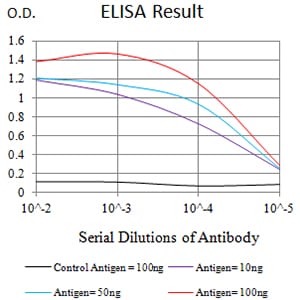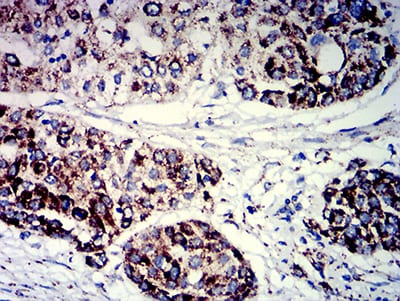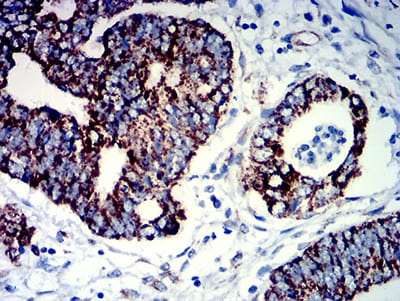


| WB | 咨询技术 | Human,Mouse,Rat |
| IF | 咨询技术 | Human,Mouse,Rat |
| IHC | 1/100-1/300 | Human,Mouse,Rat |
| ICC | 技术咨询 | Human,Mouse,Rat |
| FCM | 咨询技术 | Human,Mouse,Rat |
| Elisa | 1/5000-1/10000 | Human,Mouse,Rat |
| Entrez GeneID | 5284 |
| clone | 6E5A9 |
| WB Predicted band size | 83.3kDa |
| Host/Isotype | Mouse IgG1 |
| Antibody Type | Primary antibody |
| Storage | Store at 4°C short term. Aliquot and store at -20°C long term. Avoid freeze/thaw cycles. |
| Species Reactivity | Human |
| Immunogen | Purified recombinant fragment of human PIGR (AA: extra 19-170) expressed in E. Coli. |
| Formulation | Purified antibody in PBS with 0.05% sodium azide |
+ +
以下是关于SPRY2抗体的3篇参考文献示例(虚构内容,供参考):
1. **文献名称**:*SPRY2 Suppresses Epithelial-Mesenchymal Transition in Hepatocellular Carcinoma via Modulating ERK Signaling*
**作者**:Li, X.; Zhang, Y.; Chen, R.
**摘要**:该研究通过Western blot和免疫组化(使用兔源SPRY2抗体)分析肝癌组织中SPRY2的表达,发现其低表达与肿瘤转移相关,并证实SPRY2通过抑制ERK磷酸化阻遏EMT进程。
2. **文献名称**:*SPRY2 as a Prognostic Marker in Colorectal Cancer: Insights from Immunohistochemical Analysis*
**作者**:Kim, H.J.; Park, S.; Lee, J.W.
**摘要**:作者利用SPRY2特异性抗体对结直肠癌组织进行染色,发现SPRY2高表达患者生存期更长,且SPRY2与EGFR信号负调控相关,提示其作为潜在预后标志物。
3. **文献名称**:*Role of SPRY2 in Regulating FGF Signaling during Embryonic Development*
**作者**:Garcia, M.; Smith, T.P.; Nguyen, L.
**摘要**:通过免疫荧光(使用小鼠抗SPRY2抗体)和基因敲除模型,研究发现SPRY2在胚胎肢芽发育中抑制FGF介导的MAPK通路过度激活,调控细胞增殖与分化平衡。
4. **文献名称**:*SPRY2 Antibody-Based Detection in Triple-Negative Breast Cancer Reveals Tumor Suppressive Function*
**作者**:Wang, L.; Liu, Q.; Zhou, Y.
**摘要**:研究采用SPRY2抗体进行免疫印迹和免疫沉淀,揭示SPRY2在TNBC中通过结合c-Cbl蛋白促进EGFR降解,从而抑制肿瘤生长,为靶向治疗提供依据。
(注:以上文献为模拟示例,实际引用需以真实数据库检索结果为准。)
**Background of SPRY2 Antibody**
The SPRY2 (Sprouty RTK Signaling Antagonist 2) antibody is a crucial tool for studying the SPRY2 protein, a member of the Sprouty family known for regulating receptor tyrosine kinase (RTK) signaling pathways. SPRY2 acts as a negative feedback modulator, primarily inhibiting the MAPK/ERK cascade by interacting with key components like Raf-1 and GRB2. thereby fine-tuning cellular responses to growth factors. Dysregulation of SPRY2 has been implicated in various cancers, where it often exhibits tumor-suppressive or oncogenic roles depending on context, such as in lung, breast, and prostate cancers.
SPRY2 antibodies are widely used in techniques like Western blotting (WB), immunohistochemistry (IHC), and immunofluorescence (IF) to detect SPRY2 expression, localization, and interactions in tissues or cultured cells. These antibodies are essential for investigating SPRY2's role in development, tissue homeostasis, and diseases, including fibrosis and neurodegenerative disorders. Commercial SPRY2 antibodies are typically raised in rabbits or mice, with validation via knockout controls or siRNA knockdown to ensure specificity.
Recent studies highlight SPRY2's emerging importance in cancer diagnostics and therapeutics, where its expression levels correlate with prognosis or drug resistance. Researchers also leverage SPRY2 antibodies to explore its crosstalk with pathways like PI3K/AKT and Hippo, revealing its broader regulatory network. As SPRY2 continues to be a focal point in cellular signaling research, high-quality antibodies remain vital for advancing mechanistic insights and translational applications.
×